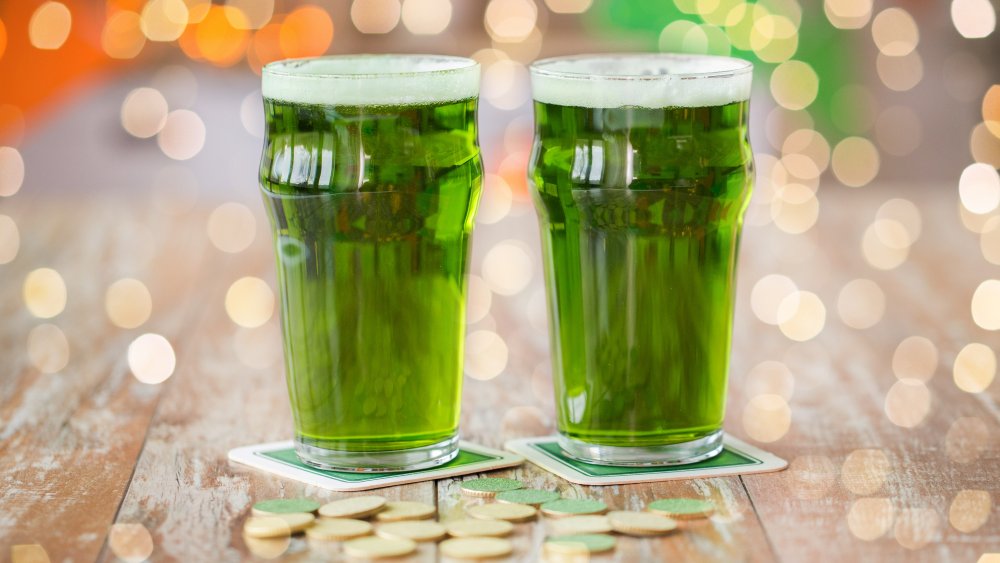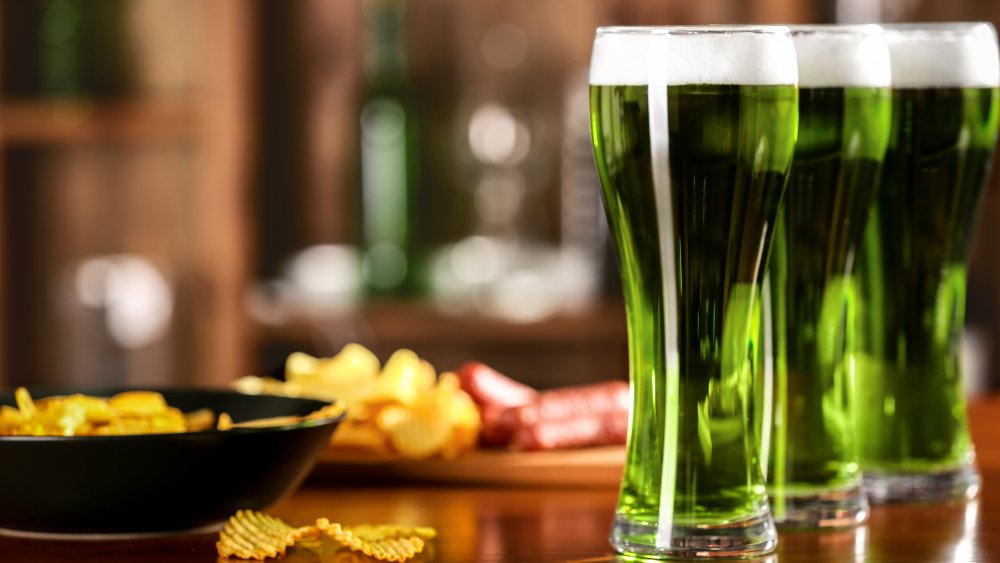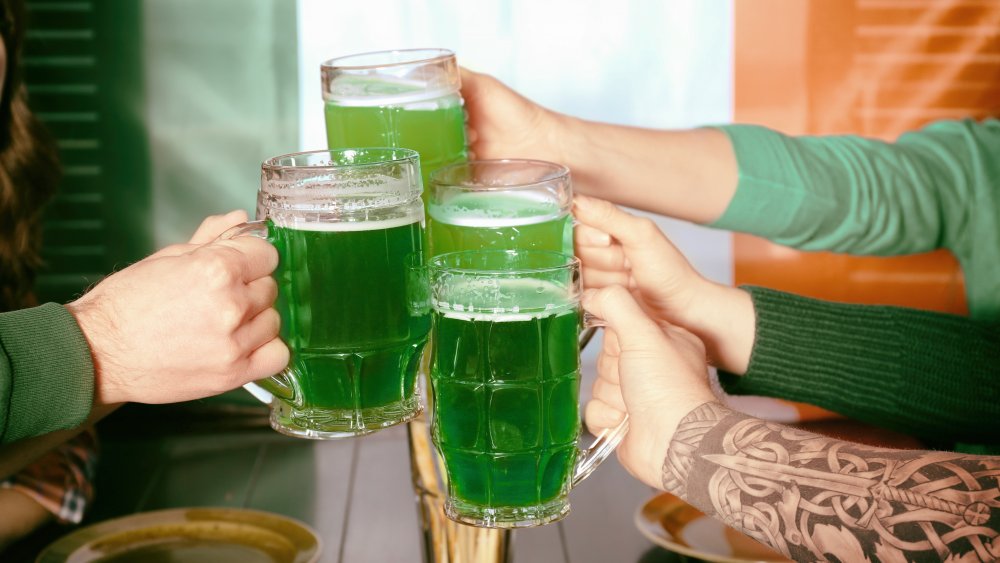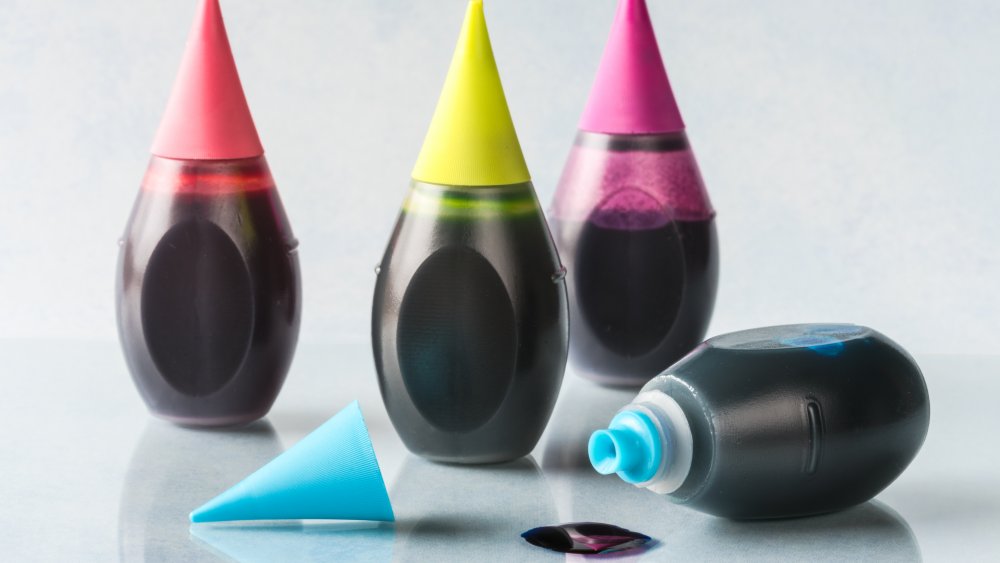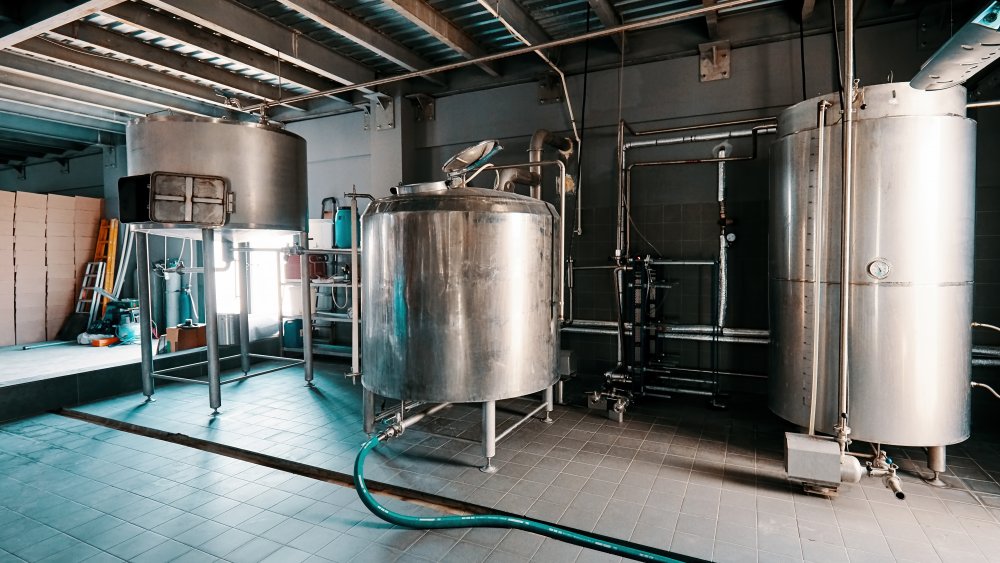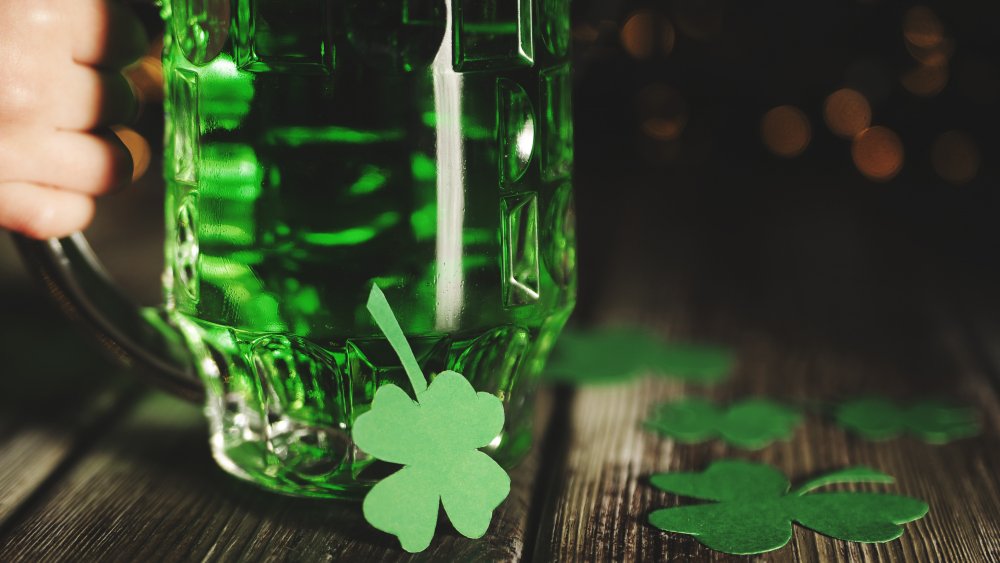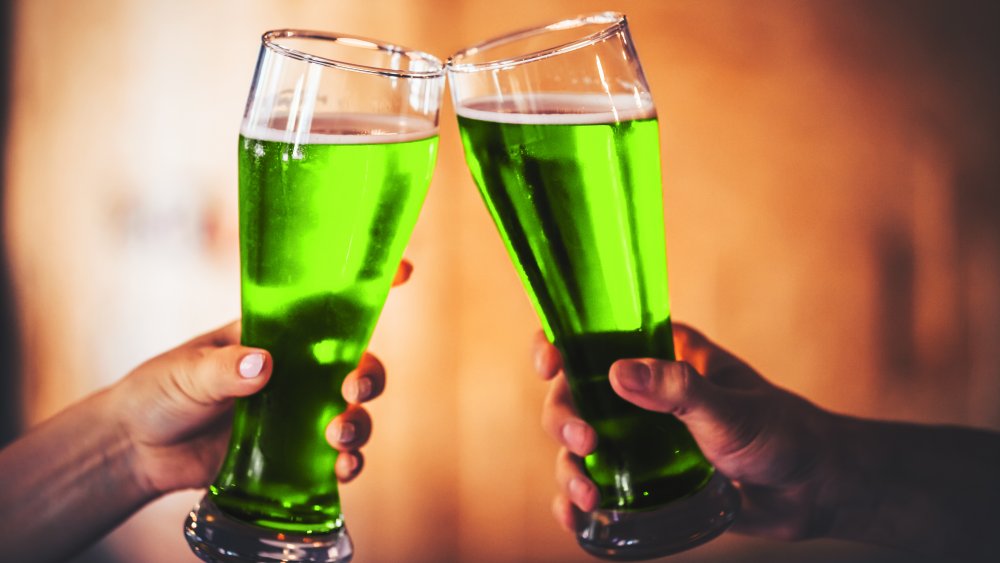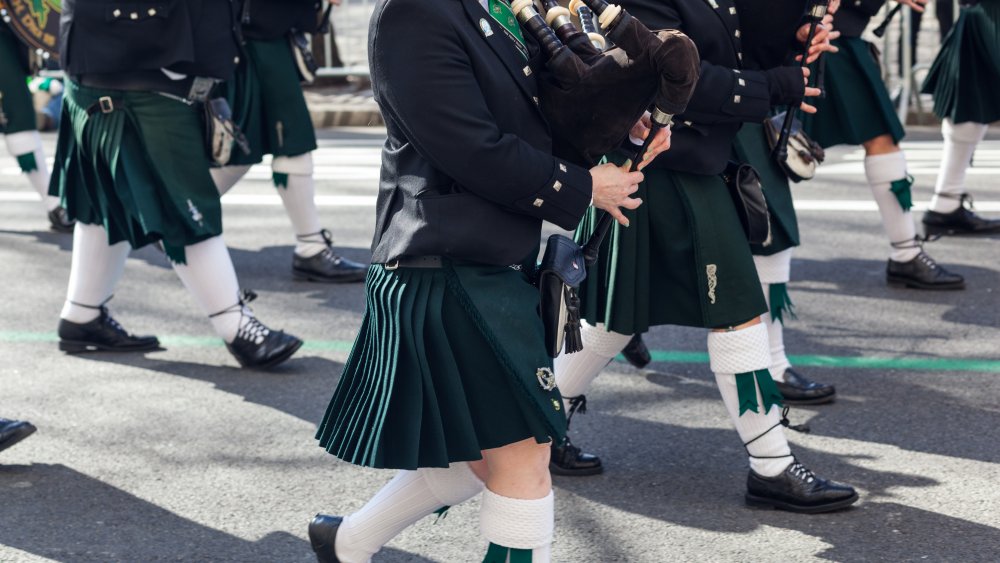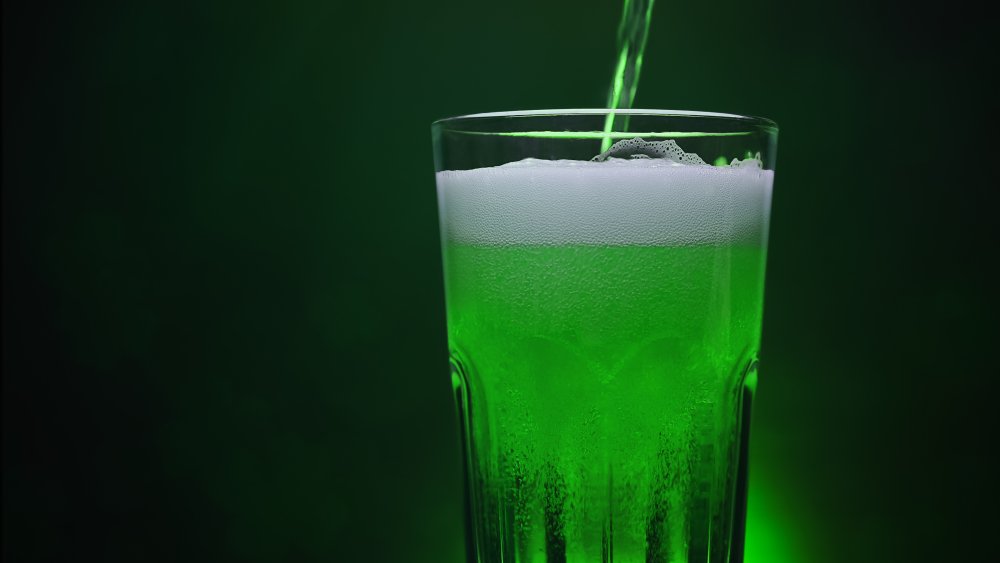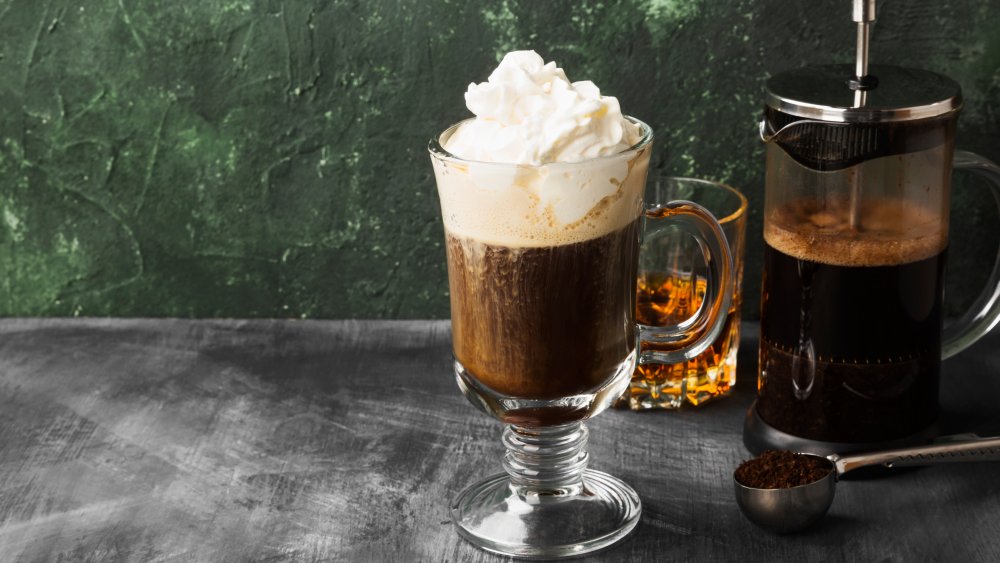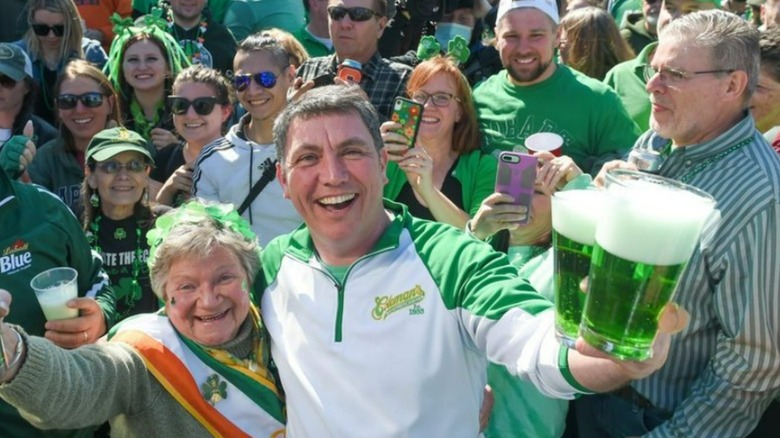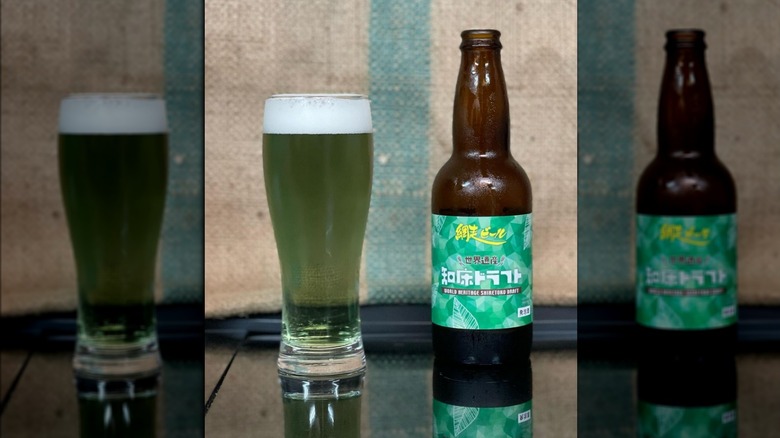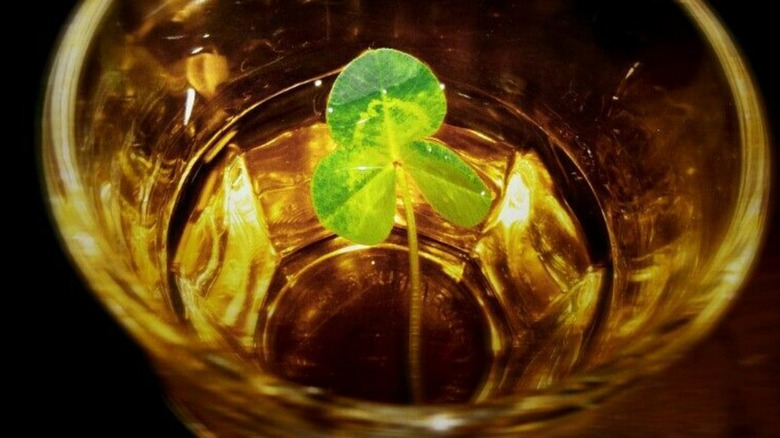Green Beer: 12 Facts About The St. Patrick's Day Brew
If you've stepped into a pub on St. Patrick's Day, whether just to grab a bite to eat or to celebrate the holiday until the bar's last call, chances are, you've been greeted by letterboards boasting specials of green food and green drinks behind the bar. Everyone is already decked out from head to toe in green and shamrocks, so why not add even more green to the celebration?
St. Patrick's Day is one of the biggest drinking holidays in the United States, and drinks like the Irish Car Bomb and pints of Guinness certainly shine in their own light. But green beer takes St. Patrick's Day to a whole new level as drinkers ring in the holiday, commemorating the Patron Saint of Ireland.
But what exactly is green beer? And where did the tradition of sipping on bright green brew come from? We decided to find out more. This is the untold truth of green beer.
1. Green beer has been around longer than you think
When you think of green beer, it may seem like a bartender decided to add green food coloring to a pint in the '80s and the craze went wild. Or, maybe it was even invented in the early 2000s, and thanks to social media, it sent the trend skyrocketing just like rainbow foods. Shockingly, unlike many trendy colorful foods, green beer has actually been going strong for longer than you think. It's been around since the early 1900s.
According to Vox, the first mention of green beer can be dated back to a 1910 mention in the Spokane Press with a headline reading, "Green Beer Be Jabbers!" At the time, at least one Spokane, Washington bar had green beer on their menu to commemorate St. Paddy's Day. In 1914, Doctor Thomas Hayes Curtin made green beer for a St. Patrick's Day event he was serving as toastmaster for in the Bronx, which was considered to be its main debut. According to Smithsonian Magazine, it was pretty well a mainstream staple at March 17 holiday celebrations by the 1950s and has only continued to grow in popularity.
2. Green beer isn't actually Irish
Although the tradition of wearing green or decking your house out for St. Patrick's Day came from the Irish Rebellion of 1798 when Irish soldiers wore green, green beer doesn't exactly follow the same suit. In fact, there's really nothing Irish about green beer at all.
When green beer first came on the map, with mentions in Spokane and then in New York, it was a completely new concept — certainly not something adopted from Ireland as a tradition of celebrating the Patron Saint. In fact, Ireland actually ended up taking over the concept from Americans in the 1980s as the popularity of green beer soared.
A 1985 article in the United Press reported that Ireland had taken on the American tradition for the very first time, having green beer shipped to pubs in the area. The concept had finally caught on in Ireland, but it took over 70 years of rising in popularity in the states to get there.
3. Green beer is not made the way you think
Certainly, you can throw green food coloring into a pale-colored beer and it will turn some shade of green, but that isn't actually the method being used in most bars on St. Patrick's Day.
According to Smithsonian Magazine, the first green beer introduced was made with a laundry whitener with an iron base called "wash blue," but the process certainly has (thankfully!) changed since then. Although, the concept of using blue is still there.
Food & Wine reports that green beer is actually made by adding blue food coloring to the beverage, whether in the keg or in the glass. As it turns out, the blue food coloring makes for the perfect match with beer's semi-yellow color. And as those two primary colors come together, they form the bold, celebratory shamrock green that everyone loves to celebrate with on the March 17 holiday.
4. There's a natural version of green beer
If the idea of sipping on beer mixed with food coloring, with the potential side effects that come along with it, isn't all too appealing, there are still other options out there. No fear, you won't have to miss out on the tradition of green beer!
There are plenty of breweries bottling their beers in green bottles now, so even if you want to skip the color altogether, you certainly can with that option. However, if you still want that green hue for Instagram photos, but you want a natural version of green beer, a brewery in Belgium has an option for you. According to Food & Wine, Belgium brewery located in Soy-Erezée introduced their Fantôme Magic Ghost ale, which is brewed with green tea, giving it that festive St. Patrick's Day hue. It's light and fruity, very much opposite to a Guinness, but it certainly offers a better option for those worried about food dyes staining their teeth.
Other brewers have also experimented with ways to brew naturally green beer. Time says a type of blue-green colored algae (also known as pond scum), spirulina, has been used as a colorant to make green beer as well.
5. Bartenders hate when you ask for green beer
You've picked out your outfit. You're decked out head to toe in shamrock green, with glitter green earrings or a hat to match, and you and your friends are ready to head out to celebrate. After all, St. Patrick's Day these days is all about eating, drinking, and having fun.
Bartending is a busy gig on most nights, especially weekends, but it's amplified when a holiday rolls around, and St. Patrick's Day is certainly one of those occasions. And really, most bartenders hate the holiday. In an interview with Forbes, Conor Myers, creative director for Underdog bar in New York (who happens to be from Ireland) said he hates the holiday, mainly because he thinks people celebrate St. Patrick's Day all wrong. '
Another New York Irishman, Jack McGarry, co-owner of the Dead Rabbit Grocery & Grog in Manhattan, holds the same sentiment stating, "It's not about paddy whackery. It's not about green rivers, green beers, and the Dropkick Murphys." And he's certainly not the only bartender to share his qualms. According to Matthew Moore of MyRecipes, who also happens to be a bartender, green beer is a ridiculous addition to the holiday and "it's all made from chemicals."
6. There are a few side effects to drinking it
By drinking green beer, all you're doing is sipping on a beer mixed with food coloring, right? What could possibly go wrong? As it turns out, green beer certainly doesn't come without its flaws — and weird side effects.
In an interview with Fox News, Dr. Partha Nandi, a board-certified gastroenterologist noted that artificial dyes and food coloring are not intended to be consumed in large amounts. Rather, consumers should stick to moderate amounts, which is pretty easy to accomplish most days. However, because St. Paddy's Day is such a popular drinking holiday, enjoying green beer doesn't always stick to those qualifications. It's difficult to stay in that moderate level when you're consuming multiple beers throughout the night, and taking in excess dyes can have consequences.
According to Dr. Braden Kuo, an assistant physician at Harvard Medical School, artificial food dyes aren't actually absorbed in the human body very well. In an interview with HuffPost, Kuo noted that the dyes can cause extra weight on the bowel, resulting in the introduction of additional water. Of course, that means that you may end your St. Patrick's Day with a bout of diarrhea on top of that already probable headache. Of course, there are a few other, less serious side effects to drinking green beer. You may also be in for green teeth and colorful stools... so there's that.
7. There's actually a Green Beer Day
There's plenty of green beer consumed on St. Patrick's Day, but New York takes that party one step further. Seriously, New Yorkers love their green beer. Perhaps, it's because New York could be considered the birthplace of green beer, but either way, they certainly don't let the chance to celebrate go to waste.
According to Syracuse.com, Syracuse's Tipperary Hill turns into a festive spot for those excited to kick off the start of the St. Patrick's Day season every year, usually a few weeks before the holiday.
The Irish Post says thousands of green beer lovers gather annually in this neighborhood with strong Irish-American influences as an Irish pub kicks off the festivities by pouring the first pint of green beer before a parade hits the streets with Irish dancers and bagpipe players. A parade is hosted annually, featuring Miss Green Beer, and pints of green beer are raised for a loud cheers to kick off the festivities.
8. You can get creative and make your own green beer
At this point, green beer is so popular you can probably walk into any bar and find it. Whether the bartenders want to serve it or not, people love it, and it makes money. But if you want to stay in and host a festive party, there are several ways to still make it yourself.
Certainly, you can opt for blue food coloring, but you'll need to make sure you have the right ratio of beer to blue. Or, if you're opting for a lighter beer like Coors Light or Bud Light, simply plan to add a few drops of green food coloring to a pitcher before pouring glasses for your friends.
But if you're looking to opt out of the artificial coloring craze, a few other options exist. According to Time, utilizing squid ink is an option, or, you can opt to mix matcha tea leaves with water. Using wheatgrass juice or simply just plain chlorophyll (yes, the stuff that makes plants green) is a possibility for DIY green beer as well. Some of those ingredients may be a little hard to track down, but your green beer-loving friends will (hopefully) appreciate your effort.
9. Green beer isn't the only way to celebrate St. Patrick's Day
Green beer is certainly fun and festive, but between bartenders hating to serve it and the fact that it isn't even an Irish tradition, you may want to consider other options to ring in St. Patrick's Day with. After all, there is a full bar of possibilities.
According to an interview with Thrillist, Sean Muldoon, owner of New York's The Dead Rabbit bar, says the first rule of thumb is to start your St. Patrick's Day celebration at breakfast with an Irish coffee made up of hot coffee, Irish whiskey, and whipped cream. Then, feel free to move into the pints of Guinness or a glass of Irish Whiskey throughout the day.
But Muldoon advises there is one thing you should never, ever order. "If you were to go to an Irish pub in Ireland and ask for an Irish Car Bomb they wouldn't know what you were talking about," said Muldoon, who added that they'd probably be offended instead. So even if you do opt for green beer, at least it will all just be in lighthearted fun.
10. Where to get yourself some of that good green beer
If the thought of what green beer might do, at least temporarily, to your teeth (i.e., turn them greenish) doesn't deter you, and you're not afraid of facing a day or two of green poop, which may or may not arrive in liquid form at inopportune moments (per HuffPost Life), then you just might be ready to take on the challenge of finding yourself some of that — as it turns out — surprisingly elusive green-hued brew.
The good news is that it is, in fact, out there. The not-so-good news is your choices will be few and far between. The even less good news is that the internet is not your friend when it comes to assisting you in this formidable task, with most searches, at least those that we initially tried, pointing to listings for eco-friendly beer, which is apparently a more popular form of green beer.
As it turns out, your best bet is to search locally for "green beer near me," or "where to find green beer in [plug in your desired location]." Doing so from, say, Scottsdale, Arizona, turns up a number of bars within 150 miles that have served green beer in honor of St. Patrick's Day in recent years, including Wally's American Gastropub in North Scottsdale's Gainey Ranch (via Fabulous Arizona), Hotel Congress and 1912 Brewing Co in Tuscon, and Bar Louie, which has locations in Glendale and Tempe.
11. Do any breweries actually make green beer?
First, a very important point of clarification: When we say "green beer," we are referring, of course, to beer that is green in color, as opposed to beer that is brewed in an environmentally mindful manner. Because if you're talking about the latter, you've got many choices, including Finland's Ant Brew, which repurposes goose poop to make an environmentally friendly brew. If you're looking for a beer that is actually green in color, then you may have to do a bit of traveling — or, at least a bit of online ordering.
There's a small craft brewery in Tuscany that makes a green beer that is sold under the brand name Spirulina Becagli. It's priced at 14 Euros per bottle and sold exclusively online in three-packs. There is also a brewery located in Hokkaido, Japan, called Abashiri Beer which makes a green-hued beer called Shiretoko Draft (via Japan Today). Beer drinkers have been copping to enjoying Shiretoko on Untappd. It's unclear where you can find this outside of Japan, but at least one importer we found might be willing to do the necessary legwork.
The fact is that a number of breweries have brewed green beer at some point or another, but some, like Dogfish Head, found that it wasn't worth making more than once.
12. Here's how Irish people traditionally get their green on St Paddy's Day
As noted earlier, the tradition of drinking green beer in honor of St. Patrick's Day is one that originated in the U.S. — which is to say, far from the Emerald Isle. Nevertheless, green beer has found its way into St. Patrick's Day celebrations in Ireland, according to Thrillist, just as it has in many other countries. So you wouldn't be wrong for thinking that drinking green beer is something the Irish do. However, if you're in the market for a more authentically Irish way of drinking in the green, so to speak, then you can't go wrong with drowning the shamrock.
According to Good Food Ireland, drowning the shamrock is a ritual that involves putting a piece of clover into your final whiskey on St. Patrick's Day. After downing the liquor, you throw the soggy plant over your left shoulder. The shamrock, as you are probably already aware, is not only associated with St. Patrick's Day but actually considered synonymous with St. Patrick, whom Irish folklore credits with explaining the Holy Trinity to his followers using a three-leafed shamrock as a visual aid. Some wear their shamrock on their lapel until it comes time to drown it at the end of the night, according to Better Drinking Culture.
